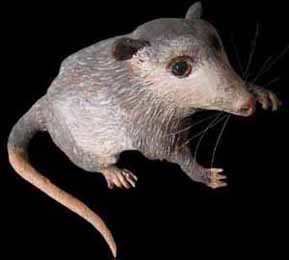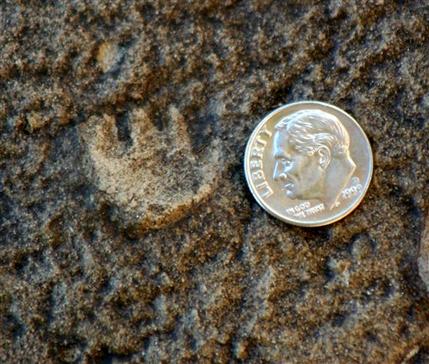Ancient Mammal Tracks Discovered
Posted by: Loren Coleman on July 23rd, 2009
This photo provided to the AP on July 23, 2009, by the Dinosaur National Monument, near Vernal, Utah, shows a small fossil mammal footprint, no bigger than a dime. Hundreds of tiny footprints left by mammals some 190 million years ago have been found on a canyon wall in a remote part of Dinosaur National Monument on the Utah-Colorado border, park officials said.
The tracks are a rare find, mostly because they were left at a time when the area was a hostile, vast Sahara-like desert where towering sand dunes seldom preserved signs of animal life.
Dan Chure, a paleontologist at the monument, and paleontologist George Engelmann of the University of Nebraska at Omaha spotted the tracks July 8 while scouring the area for fossils and other evidence from the early Jurassic period. Dinosaur National Monument, founded because of its rich and plentiful supply of dinosaur bones, straddles the Utah-Colorado border.
Most of the tracks are the size of a dime or smaller. A few include impressions of up to four toes. The mammals – perhaps the size of a rat – were among the few species that were able to survive between large sand dune fields where there was water, dinosaurs and a few plants, Chure said.
Interspersed among the mammal footprints are tracks from larger animals, possibly small dinosaurs, Engelmann said.
It might have been some kind of small mammal like Maastrichtidelphys meurismeti.

About Loren Coleman
Loren Coleman is one of the world’s leading cryptozoologists, some say “the” leading living cryptozoologist. Certainly, he is acknowledged as the current living American researcher and writer who has most popularized cryptozoology in the late 20th and early 21st centuries.
Starting his fieldwork and investigations in 1960, after traveling and trekking extensively in pursuit of cryptozoological mysteries, Coleman began writing to share his experiences in 1969. An honorary member of Ivan T. Sanderson’s Society for the Investigation of the Unexplained in the 1970s, Coleman has been bestowed with similar honorary memberships of the North Idaho College Cryptozoology Club in 1983, and in subsequent years, that of the British Columbia Scientific Cryptozoology Club, CryptoSafari International, and other international organizations. He was also a Life Member and Benefactor of the International Society of Cryptozoology (now-defunct).
Loren Coleman’s daily blog, as a member of the Cryptomundo Team, served as an ongoing avenue of communication for the ever-growing body of cryptozoo news from 2005 through 2013. He returned as an infrequent contributor beginning Halloween week of 2015.
Coleman is the founder in 2003, and current director of the International Cryptozoology Museum in Portland, Maine.











This is certainly an interesting find, at least to me, given that I have been interested in prehistoric life much longer than I have been interested in cryptozoology. The tracks shown in the pictures seem pretty well preserved – no worse than many Sasquatch tracks.
(hand raised) I’ve got a question, teacher….How do they know it was a mammal? Really all they can say for sure is that some really, really small creature ventured thru when the environment was right for its foot prints to be preserved. Although, that is quite small. I would probably miss that one.
Good question, Shumway10973. You’re a good “pupil.”
Had not thought of that myself. Tiny dinosaur, maybe???
Gotta sit next to you in the classroom from now on. 😉
Shumway – Well, the shape of the print is one indicator – dinosaurs that small usually have three-toed, birdlike tracks.
shumway 10973: GREAT question, and one that leaped into my mind the moment I saw the photo.
CI 2.0: Yes, but. All we have is that impression – one many wouldn’t have recognized as a track – and some others that I presume were no better because this is the one that got photographed. And look at the leap that’s made.
Just given some other track evidence I could talk about here but won’t (but CI does 😉 ), I just find it funny, that’s all. Way funny.
DWA – Well, animals tend to follow certain patterns with their track shapes – mammals that were around then tended to have blunter toes than those of dinosaurs of comparable size and, also, were not bipedal, whereas any adult dinosaur capable of making a track this small would almost certainly be a biped. Given these things we know about tracks from this time period, and especially the fact that we know at least one species of mammal capable of making a track like this was in the area the track is from in the general time range it is from, I don’t see the identification of it as a mammal track as too much of a leap.
CI: yes, but.
I think – not getting into that topic on this thread – that you know why I think this is funny. At least your post hints at it. 😉
It is hard to remember sometimes that everything we ‘know’ about prehistoric animals is speculation. Educated, fine. But speculation nonetheless.
I’m not sure “speculation” is the right term, DWA – I see speculation as the act of pulling something out of a hat and waving it around in the air yelling “I caught one! I caught one!”.
Whatever you want to call it, what paleontologists generally do with behavioral issues and the such is to take a long, hard look at the tag that gives detailed instructions on how to wash the hat, pulling something out of the hat, and saying, “Does that look like a polar bear to you?”. Still has a good chance of being wrong, but at least it looks like they’re doing something scientific. 😀
(As for stuff like footprints, that’s not speculation – they have the foot, and they have the print. It doesn’t take a genius to figure that a foot with three toes will make a three-toed track [though it did take a few to figure out what the absence of tail-drag marks meant for the theory that dinosaurs walked around dragging their tails].)
CI: guess I’m saying “knowledge” is having the mammal in your hand; skinning it, there’s the skeleton; there it is, and here are some tracks at the end of which we found one, that look like those feet…
In this sense, we speculate, not know, because we never had the real actual animal in front of us. (When they can’t even but speculate on the species, they don’t have the foot.) I’m not complaining about the conclusion. Educated speculation is fine by me. Sure beats saying: it’s just impressions in a rock, could be anything. Just that the incredulity that attends some other things (at which you hinted) for which by comparison we have a lot of evidence I find, well, funny.